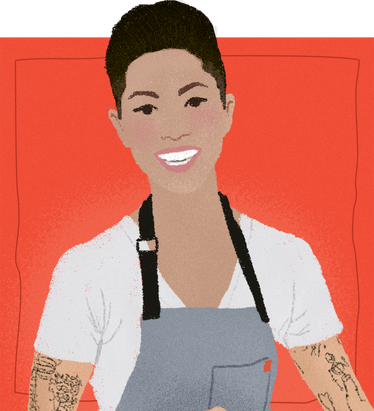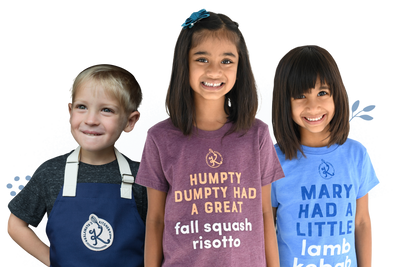
Taste Bud Profile
Kristen Kish

In a world where we're under constant pressure to compare ourselves to other people, Chef Kristen has some excellent advice for all of us: "Be yourself. Nobody else can tell your story." She continues to successfully inspire foodies and aspiring chefs through all of her incredible work, but these are words to live by in any area of your life, no matter what your passion is. I love that Chef Kristen inspires everyone to be honest with themselves so that they can be honest with everyone else about the things that make each of us truly special.



Kristen Kish: I was born in Seoul, South Korea, but adopted at 4 months old. I grew up in Kentwood, outside of Grand Rapids, MI. We always gathered around a dinner table, whether it was to eat something homemade, or takeout, or some combination of the two. We all had our spots—I always got yelled at for tipping my chair back!—and I remember how nice it was to have a few years before my brother went to college where all of us were at the table every night, together.
I think my interest in food really started around the age of 6. I loved watching Great Chefs of the World on the Discovery Channel. We had a TV in the bread garage, and I’d push a barstool over to it and perch like a little bird to watch these programs.

I really took to it. I loved what cooking looked like, and so I started to learn the motions of cooking. I didn’t understand the concept of flavor at this point. I was seeing cuisine and technique on television that I had no context for growing up in a typical midwestern suburb like I did. I didn’t know what any of this food actually tasted like, but I was picking up on the experience of creating it. So I think I went backwards—I was a very visual learner, and I started to create food based on what I thought it should look or feel like, not whether it tasted good. Learning the motions first meant that I would take every vegetable out of the fridge and just chop them up because I wanted to do what I saw on tv. It also meant playing outside, pretending my tennis racket was a frying pan, and approximating the sounds of frying with the crunchy leaves that fell thickly in my yard. I created a lot of inedible food based on what I approximated a texture to be, like when I wanted to make chocolate pudding but we had no chocolate, so I used soy sauce to make it brown.
While it must have been very annoying for my mother that I used to do things like this, she did see that I was taking an interest in something, and she let me continue to do it. Eventually I started to make food that was actually edible, but I think that starting the way I did made me realize that the motions, or the technique, were very important to the outcome of the dish.
I was lucky that both sets of grandparents lived fairly close by, and that both of my grandmothers cooked a lot. I remember that whether they were at my house or I was at one of theirs, I was always in the kitchen with them—not really doing anything, but just being there. My grandma Kish used to make Hungarian stuffed cabbage for all of our special occasions—it’s sausage mixed with rice rolled into cabbage leaves, simmered with sauerkraut, and she’d serve it with vinegar sour cream cucumbers on the side. I’d stand on a step stool, watching her arrange the cabbage in a big tall stock pot, and just loving how the house smelled like it all day. I never made the dish myself till I was an adult, but something always stuck with me there. My other grandma made more baked and sweet things—snickerdoodle cookies and homemade bread. I was very fortunate to have two grandma babysitters constantly perfuming the home with their cooking.

It took me a very long time to figure out who I was as a chef and as a person. I found that the greatest success as a chef happened when I got very honest with myself—when I stopped trying to be a chef that impresses everyone and just tried to tell my own story through my food.
I stopped thinking about “how” to create a new dish, and I just did it using inspiration from my own upbringing. That’s when things really started taking off for me. My food story now is basically my childhood. Not a recreation, but an homage to the things I remember, delivered through my own creative lens and a very focused, honed technique. I have a dish at my restaurant that was inspired, very honestly, by Hamburger Helper. Once I figured out that the magic sauce was just being me, my life really came together. For a long time I tried to be so many other things, so many other versions of myself, personally and in the kitchen. It was exhausting. Everything was harder than it had to be. Eventually, with a lot of work and a lot of mistakes, the easiest thing to do was to just be myself, and use my life as the point of inspiration for creativity.
You have to have technique and a point of view to succeed, in my opinion. With those two things, you have something to get you moving. Chefs are often fed the idea that they have to create something that has never been done before. Well, here’s some tough news—everything has been done before. The only thing that has never been done before is the telling of who YOU are, told through the lens of food. Nobody else can tell your story.
That’s what you have to do to stand out. I wish somebody had told me that a lot sooner! And this translates into your personal life as well. The way to be the most uniquely amazing beautiful person that the world needs is to be the person you were meant to be—uniquely you. Being yourself is such a simple concept, and so hard to do, but I believe it’s the right kind of work. It takes patience too. But if you can learn to take things slowly, to learn what you need to learn in order to start moving, then your journey will be an authentic one.
I’m also grateful that I had parents who allowed me the space to make mistakes. It must be very difficult to be a parent and to watch your kid struggle, and not step in to fix it for them. But ultimately it’s how I grew. Trying to curate a perfect life for your child isn’t going to help them in the future.
And just as my parents didn’t do that for me, I worry about how we do it to ourselves—trying to curate the perfect looking life, cushioning ourselves and our outward presence from the bad, and creating fake little worlds for ourselves on the internet. There’s a lot of pressure and messaging that bombards us with what “success” really looks like, but it’s a distraction. You can’t connect the dots in your own life if you’re constantly measuring against someone else’s. Learn to unapologetically move through your own journey. It’s what I want to encourage for other people because it was so important for me.

